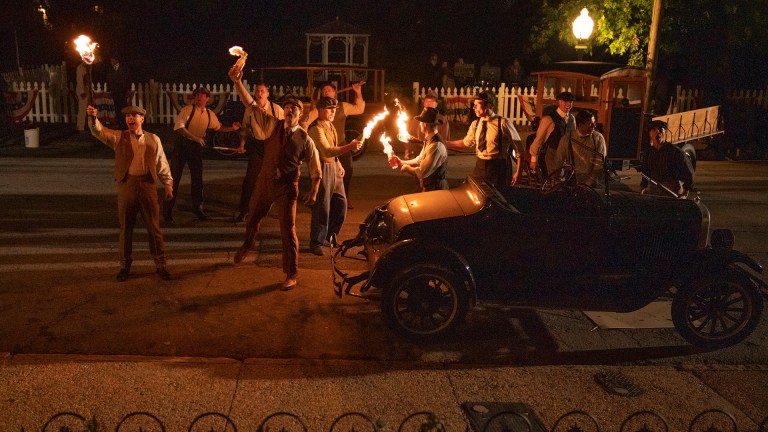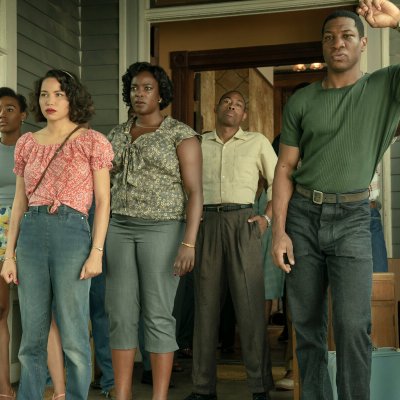Lovecraft Country: The Real History Behind Tulsa 1921
In its penultimate episode, Lovecraft Country season 1 takes viewers into the heart of the Tulsa Race Massacre.

This article contains spoilers for Lovecraft Country episode 9.
“Rewind 1921” is the second in as many episodes of Lovecraft Country that draws directly from a real historical event. In it, Tic, Leti, and Montrose travel to the past to retrieve the Book of Names from the last place it was known to be, in the hands of Tic’s family in Tulsa, Oklahoma in 1921.They arrive in Greenwood, overlooking Black Wall Street, the night of the Tulsa Race Massacre (also known as the Tulsa Race Riot, the Greenwood Massacre, the Black Wall Street Massacre, the Tulsa pogrom, or the Tulsa Massacre).
Lovecraft Country is not the first show this TV season to bring attention to what the Oklahoma Historical Society calls “the single worst incident of racial violence in American history.” The series premiere of HBO’s Watchmen opens on the Tulsa Massacre, which becomes an anchor point of sorts for the entire story. In the show’s reality, the racial divide is reflected in the social and political structures of modern-day Tulsa, which seem more impacted by the massacre than real-world Tulsa, which largely kept quiet about the horrific event.
Like so many atrocities committed against Black communities during the Jim Crow era, the Tulsa Race Massacre was the violent reaction to a false report made against a Black boy by or about a white woman. On May 20, 1921, 19 year-old Dick Rowland was taking the elevator up to the top floor of the Drexel building to use the coloreds-only bathroom when he apparently tripped and, in an attempt to catch himself, accidentally grabbed the elevator operator, 17 year-old Sarah Page. She screamed in response, and a white clerk on the first floor called the police to report an assault, saying Rowland ran away from the scene.
The next day, May 31, Dick Rowland was arrested. The Tulsa Tribune ran the headline “Nab Negro for Attacking Girl in Elevator” which reported the story as an attempted sexual assault. White folks swarmed the courthouse where Rowland was being held, and a small group of about 25 armed Black World War I vets went to the courthouse and offered to aid law enforcement in protecting Rowland. They were refused, but later returned in larger numbers when rumors spread of a possible lynching. Law enforcement again refused their aid, and when they were leaving, a white man tried to disarm a Black vet, and shots were fired. The riot—slaughter—began.
Black folks in Greenwood did what they could to protect themselves—like we see with Tic’s family in Lovecraft Country—but were vastly outnumbered by white folks, who streamed into the neighborhood by the carloads, armed to the teeth. Law enforcement had deputized and armed white members of the lynch mob, which gave them carte blanche to act the goddamn fool. Whites attacked and killed people indiscriminately, looted, and burned buildings. Private Aircraft dropped incendiaries on the neighborhood, imagery we see in both Lovecraft Country and Watchmen. The aerial assault is detailed in the first-hand account from Buck Colbert Franklin:
“The side-walks were literally covered with burning turpentine balls. I knew all too well where they came from, and I knew all too well why every burning building first caught from the top. I paused and waited for an opportune time to escape. ‘Where oh where is our splendid fire department with its half dozen stations?’ I asked myself. ‘Is the city in conspiracy with the mob?’”
By the morning of June 1, 1921, 35 city blocks were reduced to ash, with over 1260 homes and 600 Black-owned businesses burned. Adjusted for inflation, over $30 million in real estate and personal property was lost. Over eight hundred people were treated for injuries. Martial law was declared and over six thousand Black folks were interned at the local convention center and fairgrounds, some for up to eight days. The estimated death toll at the time was thirty six, but historians now believe that number to be anywhere from 100–300 people, mostly Black. Investigations into mass graves are still ongoing.
To say the Tulsa Race Massacre was just about Dick Rowland and Sarah Page would be oversimplifying. The Greenwood District of Tulsa, OK was home to 10,000 Black folks, some of whom were among the wealthiest in the nation. It was an economically prosperous African-American community that was thriving amidst the poverty of surrounding areas. Greenwood Avenue, or Black Wall Street, was its bustling epicenter, it featured luxury shops, restaurants, movie theaters, and other venues— all of the things you’d expect to see in an upscale shopping district today. Poor whites were jealous of the affluence of people they believed to be beneath them, which only furthered their general hostility toward their Black neighbors. To put it plainly, white folks just needed a reason, and the sham of a charge against Dick Rowland gave them one.
Next year will mark the centennial of the Tulsa Race Massacre, which may explain the recent interest in storytelling surrounding the event. Science-fiction and fantasy, with its allegories, gives us a safe place to explore and unpack real trauma. But metaphors can and often do go over people’s heads, especially when the audience is expected to empathize with protagonists they can’t identify with. It is sometimes necessary to ground stories in real historical contexts, or to recreate real moments from history, and both Lovecraft Country and Watchmen do this to devastating and powerful effect in their graphic depictions of the Tulsa Race Massacre.

